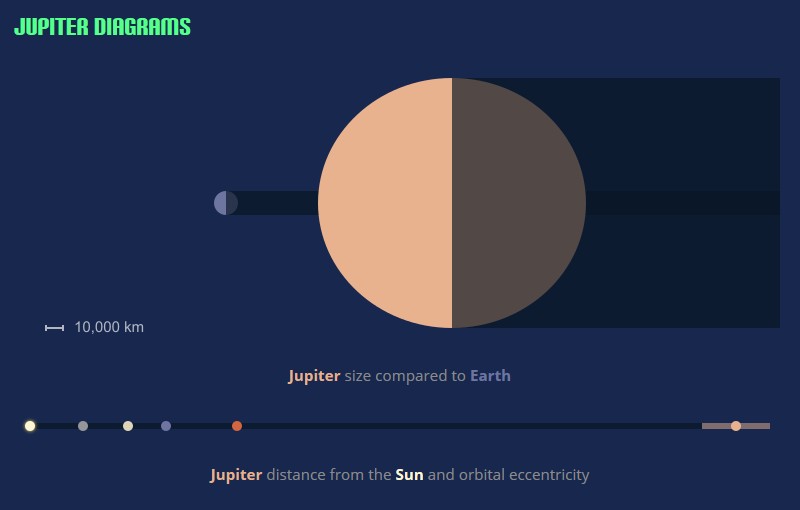Jupiter Planet Profile
|
Equatorial Diameter:
|
142,984 km (88,846.1 mi)
|
|
Polar Diameter:
|
133,709 km (83,082.9 mi)
|
|
Mass:
|
1.90 × 10^27 kg (318 Earths)
|
|
Moons:
|
95 (Io, Europa, Ganymede, Callisto)
|
|
Rings:
|
4
|
|
Orbit Distance:
|
778,340,821 km (483,638,563.9 mi) (5.20 AU)
|
|
Orbit Period:
|
4,333 days (11.9 years)
|
|
Effective Temperature:
|
-148 °C (-234.4 °F)
|
|
First Record:
|
7th or 8th century BC
|
|
Recorded By:
|
Babylonian astronomers
|
|

|
Detailed Jupiter Facts
- Jupiter is the fourth brightest object in the solar system.
Only the Sun, Moon and Venus are brighter. It is one of five planets visible to the naked eye from Earth.
- The ancient Babylonians were the first to record their sightings of Jupiter.
This was around the 7th or 8th century BC. Jupiter is named after the king of the Roman gods. To the Greeks, it represented Zeus, the god of thunder. The Mesopotamians saw Jupiter as the god Marduk and patron of the city of Babylon. Germanic tribes saw this planet as Donar, or Thor.
- Jupiter has the shortest day of all the planets.
It turns on its axis once every 9 hours and 55 minutes. The rapid rotation flattens the planet slightly, giving it an oblate shape.
- Jupiter orbits the Sun once every 11.8 Earth years.
From our point of view on Earth, it appears to move slowly in the sky, taking months to move from one constellation to another.
- Jupiter has unique cloud features.
The upper atmosphere of Jupiter is divided into cloud belts and zones. They are made primarily of ammonia crystals, sulfur, and mixtures of the two compounds.
- The Great Red Spot is a huge storm on Jupiter.
It has raged for at least 350 years. It is so large that three Earths could fit inside it.
- Jupiter's interior is made of rock, metal, and hydrogen compounds.
Below Jupiter's massive atmosphere (which is made primarily of hydrogen), there are layers of compressed hydrogen gas, liquid metallic hydrogen, and a core of ice, rock, and metals.
- Jupiter's moon Ganymede is the largest moon in the solar system.
Jupiter's moons are sometimes called the Jovian satellites, the largest of these are Ganymeade, Callisto, Io and Europa. Ganymeade measures 5,268 km (3,273.4 mi) across, making it larger than the planet Mercury.
- Worthy of note: Simon Marius (born in Bavaria 445 years ago this week [Saturday, January 20th, 1573]) first observed Jupiter's four largest moons around the same time Galileo did. Though the honor of the moons' discovery goes to Galileo, Marius is responsible for the names assigned to them: Io, Europa, Ganymede, and Callisto.
- Side note: Marius observed objects even farther afield, and is credited with the first telescopic observation of the Andromeda Galaxy, which he likened to the diffused light of a candle glowing within a lantern.
- Jupiter has a thin ring system.
Its rings are composed mainly of dust particles ejected from some of Jupiter's smaller worlds during impacts from incoming comets and asteroids. The ring system begins some 92,000 kilometers (57,166.2 miles) above Jupiter's cloud tops and stretches out to more than 225,000 km (139,808.5 mi) from the planet. They are between 2,000 to 12,500 kilometers (1,242.7 to 7,767.1 miles) thick.
- Nine spacecraft have visited Jupiter.
Pioneer 10 and 11, Voyager 1 and 2, Galileo, Cassini, Ulysses, New Horizons, and Juno missions. Other future missions may focus on the Jovian moons Europa, Ganymede, and Callisto, and their subsurface oceans.
- Science Fiction Books - Jupiter
- Asimov, Isaac (writing as Paul French)
- Lucky Starr
- Lucky Starr and the Moons of Jupiter (1957)
- - Synopsis -
Lucky Starr and the Moons of Jupiter takes place in the Jovian system. In the mid-1950s, when the novel was written, Jupiter had twelve known satellites. The first half of the novel takes place on what was then the outermost known satellite, Jupiter IX, discovered by Seth Barnes Nicholson in 1914. Jupiter IX had been given the unofficial name 'Hades' in 1955, but in the novel Asimov mistakenly refers to it as Adrastea, which was the unofficial name of Jupiter XII. The confusion doubtless arose from the fact that Jupiter IX was the twelfth farthest known satellite, while Jupiter XII was the ninth farthest known satellite. In 1975, the International Astronomical Union gave Jupiter IX the official name Sinope. Asimov describes Jupiter IX as being 89 miles in diameter, but its diameter is now thought to be only 23 miles. Part of the novel is also set on Io, the innermost of the Galilean moons. Io is depicted as having a thin atmosphere of methane, and fields of ammonia snow and ice, as well as rivers of liquid ammonia.
- Clarke, Arthur C.
- Space Odyssey
- 2001: A Space Odyssey (1968)
- 2010: Odyssey Two (1982)
- 2061: Odyssey Three (1987)
- 3001: The Final Odyssey (1997)
- - Synopsis -
Note: Book -> Saturn; Movie -> Jupiter.
From the savannas of Africa at the dawn of mankind to the rings of Saturn as man ventures to the outer rim of our solar system, 2001: A Space Odyssey is a journey unlike any other. This allegory about humanity's exploration of the universe - and the universe's reaction to humanity - is a hallmark achievement in storytelling that follows the crew of the spacecraft Discovery as they embark on a mission to Saturn. Their vessel is controlled by HAL (Heuristically programmed ALgorithmic computer) 9000, an artificially intelligent supercomputer capable of the highest level of cognitive functioning that rivals - and perhaps threatens - the human mind. Grappling with space exploration, the perils of technology, and the limits of human power, 2001: A Space Odyssey continues to be an enduring classic of cinematic scope.
|